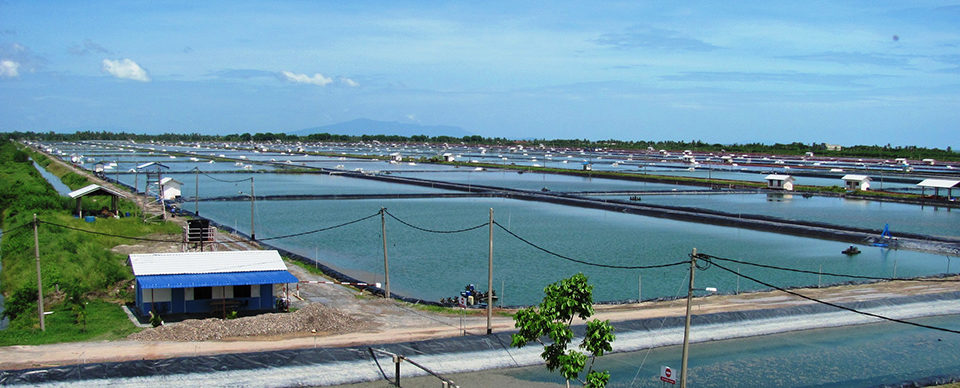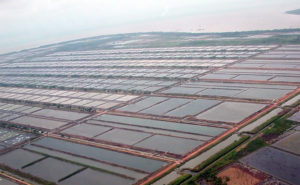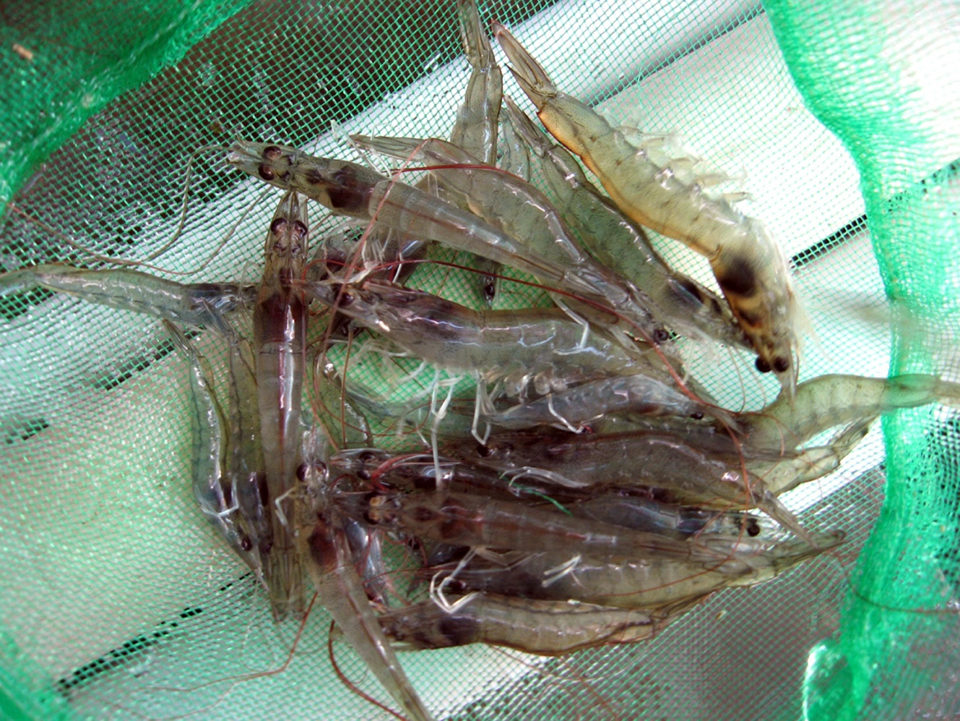Farm biosecurity and technical support are essential

Integrated shrimp farming is at present the most desirable system due to its ability to provide the food safety and traceability required by many shrimp-importing countries. Integrated seafood companies have hatchery, farm, feed and processing plant facilities that work together with complete traceability.
The most challenging element of integrated aquaculture businesses is the farm. There have been several cases in Indonesia where integrated shrimp companies collapsed due to their farms’ failure to produce. The successful operation of a large integrated shrimp farm rests on a number of factors, including farm location, layout and pond construction; biosecurity; technology and technical management.
Advancing technology

Most shrimp farms built during the mid-1980s were located within a feasible range for operation with present technology. However, the major challenges are in farm construction layout and technology.
At many large shrimp farms constructed in the 1980s, the ponds were lined with high-density polyethylene and set up in rows with inlet and outlet canals at opposite sides. Water was pumped directly into the ponds. During this period, antibiotic residues became an issue in some farmed shrimp.
From the early 1990s, reservoirs in which to promote phytoplankton were introduced to reduce stress due to sudden environmental changes and control vibrio issues in shrimp without the use of antibiotics. Some farms were designed with water recirculation systems.
With the appearance of white spot syndrome (WSS) in Asia in late 1994, concepts changed further, and the major focus became how to prevent or control viral problems. The 2002 introduction of specific pathogen-free Litopenaeus vannamei to Asia again changed culture technology.
Intensive culture with high stocking densities has become very popular among shrimp farmers. Minimal water exchange and biosecure technology appear to prevent or control the WSS. Treated water is used as much as possible.
Recently, biofloc technology has also become popular. The systems have a stable culture environment and better biosecurity, and reduce feed-conversion rations – all of which lead to greater economic returns.
Integrated farming
There are many large integrated shrimp farms in Asia, especially in Indonesia. Although challenging, integration is a very good concept in which different major production facilities meet the needs of other companies. However, each company must not take it for granted that whatever it produces will be absorbed by the sister companies. This attitude has led to the failure of more than one integrated business.
Companies within the integrated structure must produce the high-quality, competitive products required by their sister companies. And all facilities within the integrated system must have the right to refuse products from their partners if quality slips. Each unit must be sustainable as a profit center by itself and, at the same time, coordinate with and fulfill the requirements of other units.
Production planning
Production planning is the most essential exercise in integrated systems. Effective coordination among the hatchery, farm, feed mill, processing plant and marketing becomes very important.
Before a production cycle begins, a complete culture operation schedule from stocking to harvest needs to be established based on market demand from the processing plant. The requirements for postlarvae, feed and other inputs need to be worked out within a budget to enable the respective units to prepare. Estimated requirements will need to be updated monthly and later weekly for smooth operations.
The major understandings that need to be established among hatchery, farm, feed mill and processing are on quantity and quality. The parties need to agree on standard operating procedures approved by the units involved before the transfer of postlarvae, feed or shrimp at harvest. The size and quality of shrimp required for the market need to be known before the farm starts stocking for production, and there should be no compromise on quality throughout the production process.
Farm biosecurity
Farm biosecurity starts with farm layout and construction. Most large farms – some with up to 200 ponds – built in the 1980s did not have reservoirs or sedimentation ponds to treat waste water. Some had large reservoirs, but only one or two to supply the whole farm. Most of the supply and discharge water gates were adapted from agriculture irrigation systems.
In many cases, important elements of different farm systems were mixed, which led to biosecurity breaches and resulting production failures. However, large 1980s-era shrimp farms in Indonesia and Malaysia have been redesigned successfully into biosecure, modular systems with reservoirs for treatment.
Farm biosecurity is challenging due to the large area farms occupy and the large number of workers involved. All personnel within the company need to be educated on biosecurity, including senior management, since all are potential disease carriers. Invited guests need to go through biosecurity protocols before entering farm facilities.
In the case of a biosecurity breach or suspected disease outbreak, swift action needs to be taken with established protocols. Do not wait for confirmations such as polymerase chain reaction reports.

Technical, lab support
Technicians come from different backgrounds and have varied experience and mindsets. For a large farm to effectively control the many technical aspects of operation, training and workshops are required to come up with the best possible technology for a production cycle. Short and informative guidelines are very important information for technicians down to pond operators.
Senior technical staff need to provide a clear outline for operation before a cycle begins. Once decisions are made on systems and technology for a cycle, no one person should be allowed to change them. If change is indicated, the issues need to be discussed at a technical meeting.
Laboratory services are essential to support culture operations with good data on postlarvae quality, pond and water conditions, feed and chemical use, and shrimp quality at harvest. Shrimp health monitoring is another area laboratory technicians need to address.
Laboratory technicians need to be independent, should there be any confusing issues or incidents during production. In addition to testing, laboratory technicians should provide regular technology updates to farm technicians.
Incentives
Farm success or failure depends on farm technicians from production managers and supervisors down to the pond operators who are directly responsible for day-to-day culture activities. Their motivation is crucial for the success of farm operations. A simple incentive system based on results for targeted production and quality can help provide such motivation.
A number of incentive systems are used in Indonesia, Malaysia and Asia. The best are based on only two or three factors. At large farms, incentives often consider production volume, shrimp size and feed conversion. Others examine only production and feed-conversion ratios, the main economic factors at farms. Incentives at small farms are usually based only on production.
Normally, pond operators earn the most when targets are met. Due to their higher salaries, managers and supervisors see lesser incentives. Support personnel actively involved in production, such as engineers and laboratory technicians, should also get incentives based on production, but in lesser amounts.
Another motivation for senior technical staff is attendance at national and international aquaculture seminars and meetings. Participation in these meetings widens their outlook on advancing technology and makes them greater assets to the company.
Effective management
Managing a large shrimp farm in an integrated concept is very challenging. Senior management personnel are typically non-technicians. Failures at large shrimp farms are often due to misunderstandings between senior managers, who define policies and hold authority, and the technicians who are responsible for production.
Senior managers need to clearly understand the realities of raising shrimp and fish in water, for unlike terrestrial farming of chickens or cattle, the stock can not be so easily observed. For aquaculture animals, management can only estimate how they are doing. Good support and understanding of technology are essential for successful production at shrimp farms.
(Editor’s Note: This article was originally published in the September/October 2011 print edition of the Global Aquaculture Advocate.)
Author
-

Nyan Taw, Ph.D.
General Manager/Senior Technical Advisor
Blue Archipelago Bhd.
T3-9, KPMG Tower, 8 First Avenue
Persiaran. Bandar Utama 47800
Petaling Jaya, Selangor, Malaysia
Tagged With
Related Posts

Health & Welfare
A holistic management approach to EMS
Early Mortality Syndrome has devastated farmed shrimp in Asia and Latin America. With better understanding of the pathogen and the development and improvement of novel strategies, shrimp farmers are now able to better manage the disease.

Responsibility
A look at various intensive shrimp farming systems in Asia
The impact of diseases led some Asian shrimp farming countries to develop biofloc and recirculation aquaculture system (RAS) production technologies. Treating incoming water for culture operations and wastewater treatment are biosecurity measures for disease prevention and control.

Intelligence
An inside look at Sino Agro Foods’ giant prawn MegaFarm
Sino Agro Foods has developed a proprietary recirculating aquaculture system that yields high production volumes and profitability. The facility should significantly contribute to seafood production in China and to help satisfy increasing demand for high value, safe and sustainably produced seafood.

Aquafeeds
Analyzing the hydrostability of shrimp feeds
The physical integrity and nutrient leaching of shrimp aquafeeds are important aspects in their quality control. The water stability of shrimp aquafeeds is often evaluated in various subjective manners. This analytical procedure provides a baseline for the aquafeed manufacturer to assess product quality.

